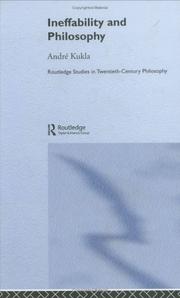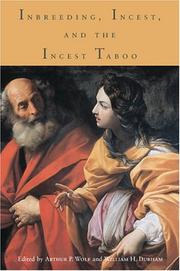| Listing 1 - 10 of 71 | << page >> |
Sort by
|
Book
ISBN: 0804791694 9780804791694 9780804789677 0804789673 Year: 2014 Publisher: Stanford, California
Abstract | Keywords | Export | Availability | Bookmark
 Loading...
Loading...Choose an application
- Reference Manager
- EndNote
- RefWorks (Direct export to RefWorks)
Why do most people never have sex with close relatives? And why do they disapprove of other people doing so? Incest Avoidance and Incest Taboos investigates our human inclination to avoid incest and the powerful taboo against incest found in all societies. Both subjects stir strong feelings and vigorous arguments within and beyond academic circles. With great clarity, Wolf lays out the modern assumptions about both, concluding that all previous approaches lack precision and balance on insecure evidence. Researchers he calls "constitutionalists" explain human incest avoidance by biologically-based natural aversion, but fail to explain incest taboos as cultural universals. By contrast, "conventionalists" ignore the evolutionary roots of avoidance and assume that incest avoidant behavior is guided solely by cultural taboos. Both theories are incomplete. Wolf tests his own theory with three natural experiments: bint'amm (cousin) marriage in Morocco, the rarity of marriage within Israeli kibbutz peer groups, and "minor marriages" (in which baby girls were raised by their future mother-in-law to marry an adoptive "brother") in China and Taiwan. These cross-cultural comparisons complete his original and intellectually rich theory of incest, one that marries biology and culture by accounting for both avoidance and taboo.
Book
ISBN: 1554415160 Year: 2003 Publisher: Chicoutimi, Quebec : J.-M. Tremblay,
Abstract | Keywords | Export | Availability | Bookmark
 Loading...
Loading...Choose an application
- Reference Manager
- EndNote
- RefWorks (Direct export to RefWorks)
Transgression (Ethics) --- Anthropology. --- Taboo. --- Magic.
Book
ISBN: 9781443878722 1443878723 9781443874502 1443874507 Year: 2015 Publisher: Newcastle upon Tyne, England : Cambridge Scholars Publishing,
Abstract | Keywords | Export | Availability | Bookmark
 Loading...
Loading...Choose an application
- Reference Manager
- EndNote
- RefWorks (Direct export to RefWorks)
The word ain't is used by speakers of all dialects and sociolects of English. Nonetheless, language critics view ain't as marking speakers as ""lazy"" or ""stupid""; and the educated assume ain't is on its deathbed, used only in clichés. Everyone has an opinion about ain't. Even the grammar-checker in Microsoft Word flags every ain't with a red underscore. But why? Over the past 100 years, only a few articles and sections of books have reviewed the history of ain't or discussed it in dialect cont...
Taboo, Linguistic. --- English language --- Linguistic taboo --- Ineffable, The --- Taboo --- Semantics. --- Semasiology --- English language Semantics --- Semantics
Book
ISBN: 1531500447 1531500110 1531500102 9781531500085 9781531500092 1531500080 1531500099 9781531500115 Year: 2022 Publisher: [S.l.] Baltimore, Md.
Abstract | Keywords | Export | Availability | Bookmark
 Loading...
Loading...Choose an application
- Reference Manager
- EndNote
- RefWorks (Direct export to RefWorks)
"Drawing on sources as diverse as Supreme Court decisions, nightclub comedy, congressional records, and cultural theory, Obscene Gestures explores the many contradictory vectors of twentieth-century moralist controversies surrounding literary and artistic works from Henry Miller's Tropic of Cancer to those of Toni Morrison, Alice Walker, Kathy Acker, Robert Mapplethorpe, 2 Live Crew, Tony Kushner, and others. Patrick S. Lawrence dives into notorious obscenity debates to reconsider the divergent afterlives of artworks that were challenged or banned over their taboo sexual content to reveal how these controversies affected their critical reception and commercial success in ways that were often determined at least in part by racial, gender, or sexual stereotypes and pernicious ethnographic reading practices. Starting with early postwar touchstone cases and continuing through the civil rights, feminist, and LGBTQ+ movements, Lawrence demonstrates on one level that breaking sexual taboos in literary and cultural works often comes with cultural cachet and increased sales. At the same time, these benefits are distributed unequally, leading to the persistence of exclusive hierarchies and inequalities. Obscene Gestures takes its bearings from recent studies of the role of obscenity in literary history and canon formation during the late nineteenth and early twentieth centuries, extending their insights into the postwar period when broad legal latitude for obscenity was established but when charges of obscenity still carried immense symbolic and political weight. Moreover, the rise of social justice movements around this time provides necessary context for understanding the application of legal precedents, changes in the publishing industry, and the diversification of the canon of American letters. Obscene Gestures, therefore, advances the study of obscenity to include recent developments in the understanding of race, gender, and sexuality while refining our understanding of late-twentieth-century American literature and political culture"--
American literature --- Taboo in literature. --- Taboo in art. --- Minority authors --- History and criticism.
Book
ISBN: 348430913X 3111928403 3111347338 9783111347332 9783484309135 Year: 1986 Volume: 13 Publisher: Tübingen
Abstract | Keywords | Export | Availability | Bookmark
 Loading...
Loading...Choose an application
- Reference Manager
- EndNote
- RefWorks (Direct export to RefWorks)
Lexicology. Semantics --- French language --- Taboo, Linguistic --- Lexicography --- -Taboo, Linguistic --- Linguistic taboo --- Ineffable, The --- Taboo --- Langue d'oïl --- Romance languages --- Taboo, Linguistic. --- Lexicography. --- French language - Lexicography --- Lexicographie --- LEXICOLOGIE FRANCAISE --- LEXICOGRAPHIE

ISBN: 1134299710 1280106301 0203325079 9780203325070 0415339707 9780415591621 0415591627 9781134299713 9781280106309 9781134299669 9781134299706 9780415339704 1134299702 Year: 2005 Publisher: London ; New York : Routledge,
Abstract | Keywords | Export | Availability | Bookmark
 Loading...
Loading...Choose an application
- Reference Manager
- EndNote
- RefWorks (Direct export to RefWorks)
Presenting a fascinating analysis of the idea of what can't be said, this book ascertains whether the notion of there being a truth, or a state of affairs, or knowledge that can't be expressed linguistically is a coherent notion. The author distinguishes different senses in which it might be said that something can't be said.The first part looks at the question of whether ineffability is a coherent idea. Part two evaluates two families of arguments regarding whether ineffable states of affairs actually exist: the argument from mysticism and the argument from epistemic boundedness. Part thr
Ineffable, The. --- Unutterable, The --- Language and languages --- Taboo, Linguistic --- Philosophy
Book
ISBN: 147581478X Year: 2016 Publisher: Lanham : Rowman & Littlefield,
Abstract | Keywords | Export | Availability | Bookmark
 Loading...
Loading...Choose an application
- Reference Manager
- EndNote
- RefWorks (Direct export to RefWorks)
Language arts (Secondary) --- Taboo, Linguistic. --- Prohibited books. --- Social aspects.

ISBN: 0804767416 142371654X 9781423716549 9780804767415 080474596X 9780804745963 0804751412 9780804751414 Year: 2005 Publisher: Stanford, Calif. Stanford University Press
Abstract | Keywords | Export | Availability | Bookmark
 Loading...
Loading...Choose an application
- Reference Manager
- EndNote
- RefWorks (Direct export to RefWorks)
Is inbreeding harmful? Are human beings and other primates naturally inclined to mate with their closest relatives? Why is incest widely prohibited? Why does the scope of the prohibition vary from society to society? Why does incest occur despite the prohibition? What are the consequences? After one hundred years of intense argument, a broad consensus has emerged on the first two questions, but the debate over the others continues. That there is a biological basis for the avoidance of inbreeding seems incontrovertible, but just how injurious inbreeding really is for successive generations remains an open question. Nor has there been any conclusion to the debate over Freud’s view that the incest taboo is necessary because humans are sexually attracted to their closest relatives—a claim countered by Westermarck's argument for the sexually inhibiting effects of early childhood association. This book brings together contributions from the fields of genetics, behavioral biology, primatology, biological and social anthropology, philosophy, and psychiatry which reexamine these questions.
Incest. --- Consanguinity. --- Inbreeding. --- Taboo. --- Purity, Ritual --- Religion --- Sacrilege --- Breeding --- Consanguinity --- Marriage --- Heredity --- Inbreeding --- Incest --- Kinship --- Sex crimes --- Sexual intercourse --- Prohibited degrees --- Taboo
Book
ISBN: 395466187X 3939069280 Year: 2008 Publisher: Berlin MWV Medizinisch Wissenschaftliche Verlagsgesellschaft
Abstract | Keywords | Export | Availability | Bookmark
 Loading...
Loading...Choose an application
- Reference Manager
- EndNote
- RefWorks (Direct export to RefWorks)
Der Band versammelt ein breites Spektrum von Problemfeldern, die allesamt die soziale Verantwortung der Medizin und der in der Heilkunde tätigen Akteure berühren. Behandelt werden - aus historischer, wissenschaftstheoretischer und ethischer Sicht - Themen wie Transsexualität, Homosexualität, Körperidentitätsstörungen, körperliche und geistige Behinderung, Zwangsbehandlung und Hochbegabung. Dabei wird unter anderem untersucht, inwieweit die Medizin über Akzeptanz, Stigmatisierung und Pathologisierung von bestimmten Minderheiten und Personen mit abweichenden Lebensentwürfen mit entscheidet bzw.
Human body --- Social aspects. --- anthropology --- stigmatization --- acceptance --- disability --- compulsory treatment --- taboo --- MMH
Book
ISBN: 3657791213 3506791214 Year: 2021 Publisher: Paderborn Brill | Schöningh
Abstract | Keywords | Export | Availability | Bookmark
 Loading...
Loading...Choose an application
- Reference Manager
- EndNote
- RefWorks (Direct export to RefWorks)
Seitdem 2010 der frühere sexuelle Missbrauch am Berliner Canisius-Kolleg bekannt wurde, wird auch in Deutschland intensiv über den sexuellen Missbrauch an Minderjährigen durch Vertreter der katholischen Kirche diskutiert. Mit der 2018 veröff entlichten MHG-Studie begann die wissenschaftliche Aufarbeitung, an der seitdem Vertreter verschiedener Disziplinen beteiligt sind. Der Band trägt den bisherigen Forschungsstand aus den unterschiedlichen Fachgebieten (Geschichtswissenschaft, Pädagogik, Recht, Psychologie) zusammen. Deutlich wird, welche innerkirchlichen und gesellschaftlichen Bedingungsfaktoren das Fehlverhalten von Geistlichen ermöglichten. Darüber hinaus wird danach gefragt, welche Spezifika der sexuelle Missbrauch in der katholischen Kirche aufweist und inwieweit er in gesamtgesellschaftliche Phänomene eingeordnet werden muss. Zudem zeigt das Buch, inwiefern gerade historiographische Zugänge dazu beitragen können, Licht in die katholischen Dunkelräume zu bringen.
Katholische Kirsche --- historische Aufarbeitung --- Tabuisierung --- sexual abuse --- Taboo --- Catholic Church --- historical reappraisal --- Geschichtswissenschaft --- Psychologie
| Listing 1 - 10 of 71 | << page >> |
Sort by
|

 Search
Search Feedback
Feedback About UniCat
About UniCat  Help
Help News
News